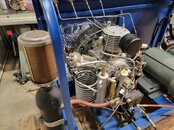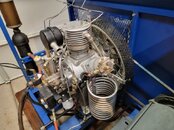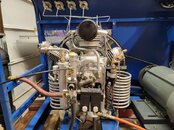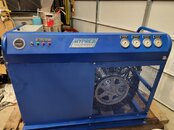wdeutsch
Registered
Background info: I just picked up a used Hypres horizontal compressor that was surplussed from a local fire department. While they *say* they maintained it well, I have some questions about that. It's got 1400 hours on it, and once the outside layer of filth/grime/oil was cleaned off, it looks pretty good. No rust. Motor and compressor flywheel turn easily. There's a rumor of an issue with the 3rd stage pressure relief valve, but I won't know about that until I fire it up.
Before I fire it up and send my first air sample for testing, I'd like to make sure there's not a bunch of buildup on the cylinder walls from poor upkeep or the switchover from mineral to synthetic oil that they did.
The Primary Question: If I remove the heads to inspect the cylinder walls, do I have to replace the head gaskets? From my experience in auto repair, it's 100% that you have to do this, but I'm hearing hints that this may not be the case in the world of breathing air compressors. If I will need to replace them, I'll get an order going so they are on hand. If it's more normal to be able to re-use, I'll give it a shot without the spares on hand. Thoughts/experience?
While we're at it, any other PM I should plan on that I haven't picked up on from reading here?
Done/To-Do includes:
Before I fire it up and send my first air sample for testing, I'd like to make sure there's not a bunch of buildup on the cylinder walls from poor upkeep or the switchover from mineral to synthetic oil that they did.
The Primary Question: If I remove the heads to inspect the cylinder walls, do I have to replace the head gaskets? From my experience in auto repair, it's 100% that you have to do this, but I'm hearing hints that this may not be the case in the world of breathing air compressors. If I will need to replace them, I'll get an order going so they are on hand. If it's more normal to be able to re-use, I'll give it a shot without the spares on hand. Thoughts/experience?
While we're at it, any other PM I should plan on that I haven't picked up on from reading here?
Done/To-Do includes:
- Thorough scrub-down of the whole unit, including detailed clean of finned final stage cooling coil
- Cleaning filter housing interiors, replacing filters, cleaning sintered separator
- Replacing intake filter
- Oil change. Compressor has synthetic oil in it currently, I'll replace/refresh with the same kind.
- Air testing
- Installation of in-line CO monitoring







